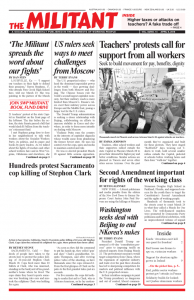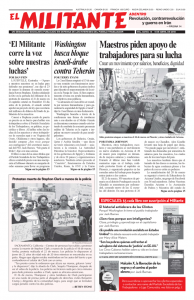The U.S. propertied rulers — who head the dominant imperialist power in the world — face growing challenges from both Moscow and Beijing. The Chinese bosses rule the world’s second largest capitalist economy, but their military reach is more limited than Moscow’s. Russia’s rulers exert their military power across Europe and the Middle East, posing a larger test for the U.S. rulers.
The Donald Trump administration is seeking a closer relationship with Beijing, collaborating on efforts to increase stability in Korea and elsewhere, in order to focus more intently on dealing with Moscow.
Vladimir Putin runs the country in the interests of capitalist oligarchs whose wealth came from plundering the former Soviet state. He uses his control over the cops, spies and media to maintain control and rule.
He was re-elected president March 18 against little serious opposition. Alexei Navalny, organizer of anti-corruption protests last year, was barred from running. Andrey Bazhutin, leader of nationwide truckers’ protests against anti-driver road taxes, said he had to stop campaigning after cop harassment and being jailed.
The Russian Communist Party ran Pavel Grudinin, the owner of a large formerly state-run farm, as its candidate. He came in a distant second to Putin. Grudinin, a former member of Putin’s United Russia Party, made little criticism of the Russian president.
The Russian capitalists operate from weakness today. Stagnation of an economy over-dependent on oil, and the effects of Moscow’s wars abroad have spurred growing working-class discontent. Tens of thousands protested across Russia against Moscow’s military intervention in Ukraine.
Putin visited Kemorovo March 27, two days after at least 64 people were killed in a fire at a shopping mall there. Just days after his election thousands protested in the city center, calling for his resignation.
With contempt for the lives of working people in this coal-mining region of Siberia, the mall managers and local officials had failed to repair a broken fire alarm and locked fire exits. Putin promised to punish those responsible while six busloads of riot police were mobilized to confront the growing numbers of protesters.
U.S. rulers aim to push Moscow back
“Russia aims to weaken U.S. influence in the world and divide us from our allies and partners,” says the U.S. government’s new National Security Strategy released in December. Moscow’s “growing military capabilities creates … the risk of conflict due to Russian miscalculation,” it states.
Putin pragmatically tests what Moscow can do to extend its influence without — he hopes — facing severe U.S. reprisals or sizable protests at home. Moscow was able to reinforce its ally, the tottering Bashar al-Assad dictatorship in Syria, and expand its military and political presence in a part of the world where the U.S. rulers have fought brutal wars over years to maintain their supremacy.
But Moscow’s military moves abroad exceed the Russian capitalist rulers’ economic reach in the world.
The Russian rulers’ moves in Syria, on the heels of their seizure of Crimea and war in eastern Ukraine, were met by heavier sanctions by Washington and the EU, worsening the conditions for workers in Russia.
The U.S. rulers are particularly concerned that Moscow’s advances in Syria are tied to those of Tehran. The counterrevolutionary Iranian rulers intervened there early on, sending Revolutionary Guard officers and ground troops from Hezbollah and other Tehran-backed Shiite militias. They have established military bases closer to the borders of Israel and a corridor across Iraq and Syria to ferry advanced weapons to Hezbollah. Washington is increasing its collaboration with Israel and Saudi Arabia to counter Tehran.
The government of Vladimir Putin has taken other steps to increase its sway over Russia’s “near abroad” — as the rulers call the former Soviet republics on Russia’s borders. It backs the thug rulers in Transnistria, a Moscow-sponsored breakaway from Moldova.
In January this year Moscow deployed surface-to-air missiles to Crimea, consolidating its position there. And the Russian rulers assault on the Crimean Tatars continues unabated.
Moscow has established close ties with Bosnian Serb leader Milorad Dodik, the president of Republika Srpska, a region of Bosnia and Herzegovina. Dodik calls for the region’s breakaway from Bosnia and was hit with U.S. sanctions last year for “obstructing the Dayton Accords.” After U.S. airstrikes devastated the former Yugoslavia, Washington marched representatives from Bosnia, Croatia and Serbia to Dayton, Ohio, in 1995 where it dictated an agreement. The “peace” accord coincided with the U.S. rulers’ expansion of the NATO military alliance eastward, setting up a collision with Moscow.
On March 26 Washington expelled 60 Russian diplomats, part of similar moves across Europe and elsewhere, after the U.K. government said Putin ordered the attempted killing of former Russian double agent Sergei Skripal and his daughter in England.
Finding a way to push back Moscow’s outsized use of its military power remains ahead of the U.S. rulers.

